Papers by Agnieszka Baklarz

The Annual Journal of Audit and Accounting, 2023
Methodology/research approach: It was possible to fulfi l the objective assumed by presenting a p... more Methodology/research approach: It was possible to fulfi l the objective assumed by presenting a proposal for the author’s model (function) of salary changes, which takes into account the specifi c nature of the pandemic period. When constructing and using this model, data resulting from the Database of Annual Reports of Audit Firms for 2020-2022, created at the Polish Agency for Audit Oversight – PANA since its inception in 2020, were used. The analysis of the data available in this database, at the same time those that coincided with the period of the Covid-19 pandemic and were appropriately extended for the needs of the analysis, consisted in diagnosing the peculiarities of the studied sample and establishing the characteristics of the explaining variables, as a result of which a proposal was formulated for modelling the issue undertaken.
Results: The article confi rms the existence of a dependence of the remuneration for statutory audit services on the type of the fi nancial statement audited, the “high” or “low” season of performing the audit and the distance between the audit fi rm and the entity audited. In addition, it focuses on a deeper understanding of the sign of the coefficient appearing in the model with the variable indicating the season. The study has also indicated a trend of undertaking fi nancial statement audit assignments from entities relatively more distant from the audit firm.
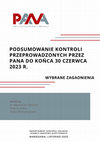
Polish Agency for Audit Oversight, 2023
The analysis of 155 inspection protocols indicated the main directions for corrections in the act... more The analysis of 155 inspection protocols indicated the main directions for corrections in the activities of audit firms. The conclusions from the previous study have not undergone significant changes. Generally, it can be observed that there is a relationship between a properly designed and implemented quality control system in an audit firm and the number and quality of irregularities identified in the audit documentation. It can also be noted that more frequent and critically conducted quality controls of assignments translate into better quality of opinions issued in audit reports. This is clearly reflected in the analysis of the number of irregularities in the audits of financial statements of Public Interest Entities (audit assignment quality control is mandatory) compared to the number and quality of irregularities in the audits of financial statements of entities other than Public Interest Entities. Due to the separation of domain controls, it became possible to more accurately analyze certain substantive areas of irregularities. As a result, a description of irregularities in audits of financial statements of investment funds has been prepared.
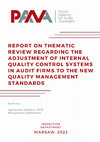
Polish Agency for Audit Oversight, 2023
The key changes compared to the former quality control standards include:
- a more proactive appr... more The key changes compared to the former quality control standards include:
- a more proactive approach to quality management adapted to the method and scope of operation of the audit firm, by focusing on achieving the set quality objectives, identified quality risks related to these objectives and responding to such risks (hereinafter referred to as the company's risk assessment process),
- greater emphasis on corporate governance and leadership requirements, including increased responsibilities and accountability of the management itself,
- modernization of standards by taking into account technology requirements, network requirements, use of external service providers,
- new information and communication requirements,
- enhanced requirements for the monitoring and remediation process to more proactively monitor the IQCS of the audit firm and correct weaknesses effectively and in a timely manner.
Summing up the irregularities in the design of the IQCS, which in particular translate into an increased risk of irregularities in the examination, the following should be pointed out:
- lack of or unclear rules related to the need to use consultations;
- lack of, unclear or unmatched with the activities of the audit firm rules related to the selection of documentation of the engagement for quality control;
- lack or imprecise manner of defining the principles of performing the quality control;
- lack of or unclear rules of rotation of the key statutory auditor or quality controller related to minimizing risks related to independence; in relation to this point, the lack of compliance with the provisions of the KSKJ1 as well as the IESBA code of ethics should also be indicated;
- lack of definition of the method of conducting ongoing monitoring;
- lack of or unclear rules for selecting a partner or an engagement for inspection;
- lack of or imprecise description of the rules for carrying out the engagement inspection;
- lack of information on how to find the root cause of irregularities;
- lack of or unclear rules for periodic monitoring, not adapted to the activities of the audit firm (along with specifying who will carry out such monitoring).
The main problem highlighted during the thematic review was the mismatch between the IQCS adapted by the individual audit firms and their actual activities. Therefore, when preparing the inspection procedures, the Agency decided to divide them due to the differences in the law (regulation, act and quality control standards) and prepared separate control procedures in relation to:
- audit firms examining public interest entities (the need to verify the fulfillment of the requirements of Regulation 537/2014 and the increased requirements of the Act and standards);
- staffed audit firms that do not audit public interest entities;
- unstaffed audit firms that do not audit public interest entities (due to the possibility of not taking into account some of the requirements of the KSKJ1).

Polish Agency for Audit Oversight, 2023
As a result of the conducted analyses of annual reports of audit firms (AF), a broader picture of... more As a result of the conducted analyses of annual reports of audit firms (AF), a broader picture of changes in the activities of these firms in the years 2020-2022 has been obtained:
1) Regarding the legal forms of AF, there is a trend of gradually decreasing participation of sole proprietorships and transforming AF into joint-stock companies.
2) There is a visible decrease in the number of AF performing financial audit activities (hereinafter referred to as active AF) with a slightly decreasing number of audit firms (BR) conducting audits.
3) The average number of statutory audits of financial statements of entities other than Public Interest Entities (JZP) in AF outside the TOP12 decreased to 11 audits. The number of audits of financial statements of entities other than JZP in firms from the TOP12 dropped to an average of 25 audits per 1 auditor for the company.
4) The number of AF with auditors performing over 50 services per year decreased to 68 (in 2022, there were a total of 150 such BR), indicating a better understanding of the need to allocate sufficient time for auditing by BR and AF. The Agency pays special attention to this phenomenon during inspections, publications, and communications, and gradual improvement should be positively assessed.
5) Information provided in the annual reports submitted by AF indicates that in 2022, 1,999 reports on the audit of statutory financial statements of JZP were issued, and 29,169 reports on the audit of statutory financial statements of entities other than JZP were issued. Regarding the audit of financial statements of JZP, 88.7% of opinions were unqualified (compared to 88.4% in 2021). Unqualified opinions, including opinions with explanatory paragraphs, accounted for, as in 2020 and 2021, 97.5% of all issued opinions. Also, concerning the audit of financial statements of entities other than JZP, the most frequent opinion issued was unqualified (82.4%, compared to 79.7% in 2021) as well as unqualified with explanatory paragraphs (12.8%, compared to 14.5% in 2021), totaling 95.2% of all issued opinions (in 2021 - 94.2%). Qualified opinions accounted for 4.5% of all issued opinions (compared to 5.5% in 2021).
6) Generally, there has been a gradual increase in audit fees. This increase is around 17%, slightly above the inflation rate for 2022 (according to data from the Central Statistical Office, the average annual consumer price index in 2022 was 14.1%).
7) Regarding the audit of funds and sub-funds, it should be noted that audit fees for this segment of audit firms are low and have essentially not increased despite a significant increase in the cost of employees performing work on audits and the cost of valuations performed by experts employed by AF.
8) The analysis of the number of audits of JZP and the fees for these audits confirms that there is a phenomenon of de-concentration of audits in the industrial processing, wholesale and retail trade, information and communication, and professional, scientific, and technical activities sectors. This is also evident in changes in fees in individual groups of audit firms. However, it is difficult to speak about de-concentration of audits in the financial and insurance activities (including associated investment funds and sub-funds) as well as in the construction industry.
9) Audits of entities other than JZP are carried out by audit firms outside the TOP12 in 75% of cases (i.e., in relation to approximately 22,000 statutory audits). However, concerning the total value of these audits, TOP12 firms perform 60% of audits, and BIG4 - 48%. In 2022, there was an increase in the number of audited financial statements by 4%. The increase mainly affected audits performed by TOP12 firms (2.5%) rather than other audit firms (1.5%). Audit firms outside the TOP12 have a dominant position in all types of audits; however, financial activities (including investment funds) are audited by TOP12 firms in close to half of the cases.
10) Regarding audits of entities other than JZP conducted by BIG4, there was a slight decrease in the number of audits of financial statements (about 1% compared to 2021). Regardless of this fact, BIG4's revenues from audits of entities other than JZP increased by approximately 12%. Of particular note is the nearly 60% increase in fees for auditing funds and sub-funds (the median value of this fee in BIG4 is over three times the median for the entire non-JZP audit market). This is the only industry where such a significant increase in fees was recorded in BIG4, and this increase continues the trend from 2021 when these fees increased by 80%. However, it should be noted that the number of funds and sub-funds audited by BIG4 accounts for only 11% of the total number of audits performed by all audit firms.
11) The structure of total revenues of AF shown in the annual reports in 2022 indicates different behavior patterns of individual groups of AF. AF from the TOP12 specialize in and mainly perform financial audit services (mostly statutory audits and reviews of financial statements). Within other services, AF from the TOP12 mainly provide unqualified attestation services not reserved for statutory auditors and related services. Other AF mainly rely on services other than financial auditing. In the case of AF from outside the TOP12 providing services to JZP, the most important
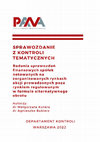
Polish Agency for Audit Oversight, 2022
Audit firms have not made sufficient efforts to adequately address these issues in their quality ... more Audit firms have not made sufficient efforts to adequately address these issues in their quality control systems, as required by mandatory standards, as evidenced by the lack of mandatory quality control of audit assignments regarding financial statements of entities on the Alternative Stock Market (ASO). Important internal factors contributing to the relatively low quality of financial statements of ASO entities include:
- Lack of significant interest from supervisory boards and management in the quality of financial reporting (including lack of communication with auditors).
- Outsourcing of accounting to accounting offices without internal control.
- Emphasis on tax accounting.
- Low attention to interim reporting.
- Sole reliance on price in selecting audit firms.
These factors are also reflected in thematic inspection findings, such as:
- Lack of documentation of communication with supervisory boards and management.
- Difficult and insufficient communication with accounting offices.
- Failure to evaluate the entity's internal control over financial reporting processes.
- Underestimation of the workload leading to inadequate audit procedures, lack of necessary consultations, failure to obtain other resources (e.g., permanent assistants ensuring adequate quality), and lack of use of quality control reviewer.
Regarding financial statement items, investors have indicated important but highly risky areas of financial reporting:
- Intangible assets and intellectual property (with particular emphasis on know-how and research and development activities).
- Financial assets (shares, stocks, and loans).
- Research and development activities (interim settlements).
- Provisions for liabilities.
Additionally, investors have raised concerns about the weak financial condition of ASO entities. It should be noted that key audit matters presented in the audit report largely reflect these areas, enriched with revenue-related risks and fraud risks. However, this reflection is not consistent with the documentation of procedures conducted by the auditor. Auditors inadequately document activities related to assessing:
- Going concern (also due to lack of communication with management and the supervisory board).
- The accuracy of significant estimates (due to poor communication with accounting offices and limitations in hiring necessary experts).
- Fraud risk.
It is also worth noting that as a result of inspections, insufficient quality of verification of a key element of the financial statement, the cash flow statement, is observed. Deficiencies in this area are rarely indicated in audit reports despite identified errors in this area during inspections.
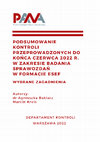
Polish Agency for Audit Oversight, 2022
This publication aims to inform, in accordance with Article 90(1)(15a)(d) of the Act on Statutory... more This publication aims to inform, in accordance with Article 90(1)(15a)(d) of the Act on Statutory Auditors, about the main issues related to the audit of European Single Electronic Format (ESEF) documents observed during inspections until the end of June 2022. The focus of this document is solely on the scope of the audit concerning compliance with Delegated Regulation 2019/815.
The analysis of inspection protocols identified the main discrepancies in understanding by the auditors under review the standardization principles of ESEF document files. According to Delegated Regulation 2019/815, the entire annual report should be prepared in XHTML format. In particular (in addition to the Financial Statement or Consolidated Financial Statement), the Activity Report and the Audit Report should be prepared in this format (as required by the regulation of the Minister of Finance of March 29, 2018, regarding ongoing and periodic information provided by securities issuers and conditions for recognizing as equivalent information required by the law of a non-member state (Journal of Laws of 2018, item 757)). The XHTML format entails a set of technical requirements that the ESEF document must meet. The mere fact that the file extension is labeled with "XHTML" or even the ability to open the file in a browser does not guarantee its correctness. Therefore, validation is necessary, for example, using an available validator. Consequently, the auditor attesting to the correctness of the report's form must subject it to appropriate validation.
Another common mistake is incorrect labeling regarding mandatory tags in consolidated financial statements. The idea behind ESEF is to enable machine-readable data, thereby facilitating data analysis, including aggregation. Mandatory tags (currently there are 10) contain data that is crucial for analysis, such as data grouping, etc. Incorrect labeling of data such as country, business form, or parent entity prevents data aggregation and analysis based on these criteria. A large number of errors make data aggregation or comparison very difficult, sometimes even impossible. There are also cases where the audit was conducted based on a file that is not an ESEF document, and an audit report was issued concerning such a file.
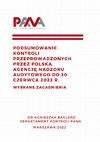
Polish Agency for Audit Oversight, 2022
The analysis of 139 inspection protocols indicated the main directions for corrective action by a... more The analysis of 139 inspection protocols indicated the main directions for corrective action by audit firms. Generally, it can be observed that there is a relationship between a well-designed and properly implemented quality control system in an audit firm and a low number and low significance of deficiencies disclosed in audit documentation. It can also be noted that more frequent and critically conducted quality control checks on assignments translate into properly issued opinions in audit reports. This is clearly reflected in the analysis of the number of deficiencies in the audits of financial statements of Public Interest Entities (PIEs) (assignment quality control is mandatory) compared to the number and quality of deficiencies in the audits of financial statements of entities other than PIEs.
However, compared to the previous year, there has been an improvement in the quality of documentation in audits of financial statements of entities other than PIEs. Nevertheless, attention is still drawn to significant weaknesses in the planning phase, which affects the entire audit.
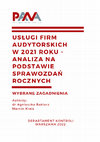
Polish Agency for Audit Oversight, 2022
As a result of the conducted analysis of annual reports, a broader picture of changes in the acti... more As a result of the conducted analysis of annual reports, a broader picture of changes in the activities of Public Accountants (PA) in the years 2020-2021 has been obtained:
1) Changes in the structure of PA forms indicate a gradual decrease in the proportion of sole proprietorships and the transformation of PAs into capital companies. There is a visible decrease in the number of PAs conducting financial audit activities (hereinafter referred to as active PAs) with a slightly decreasing number of audit teams performing audits.
2) The average number of statutory financial statement audits for entities other than Public Interest Entities (PIEs) in PAs outside the TOP11 increased to 12 audits (compared to around 11 audits in 2020), confirming the growing concentration of audits in individual PAs. The number of audits of financial statements for entities other than PIEs in firms within the TOP11 increased to an average of 32 audits per certified auditor for a given firm (compared to 27 audits in 2020).
3) The number of PAs with certified auditors performing over 50 services per year decreased from 88 to 76 (in 2021, there were a total of 174 such auditors – in 2020, there were 194), indicating a better understanding of the need to dedicate sufficient time to auditing by audit teams and PAs, as noted by the Agency during inspections, publications, and communications.
4) In 2021, 2035 opinions were issued on the audit of statutory financial statements of PIEs (compared to 1898 opinions in 2020), and 28,041 opinions were issued on the audit of statutory financial statements for entities other than PIEs. Regarding the audits of PIE financial statements, 88.4% of the opinions were unqualified (compared to 78.5% in 2020). Unqualified opinions, including opinions with an explanatory paragraph, accounted for 97.8% of all issued opinions, similar to 2020. In relation to audits of financial statements for entities other than PIEs, the most common opinion issued was an unqualified opinion (79.7%, compared to 74.4% in 2020), followed by an unqualified opinion with an explanatory paragraph (14.5%, compared to 20.9% in 2020), totaling 94.2% of all issued opinions (compared to 93.3% in 2020). Qualified opinions accounted for 5.5% of all issued opinions (compared to 4.3% in 2020).
5) Generally, there is a gradual, albeit slight, increase in audit fees. This increase is on average slightly above the inflation rate for 2021, around 7% (according to data from the Central Statistical Office, the average annual consumer price index for goods and services in 2021 was 5.1%). The increase in fees was stronger in PAs within the TOP11 (especially in PAs within the BIG4 group), which focused their activities on audits with high workload while simultaneously reducing the number of serviced entities (for BIG4, the number of audits of financial statements for entities other than PIEs decreased by nearly 23%).
6) Significant changes occurred in the structure of entities performing audits of investment funds and sub-funds. While the majority of audits (close to 80% in 2021, compared to 72% in 2020) of investment funds and sub-funds that are PIEs were conducted by BIG4 in 2021, funds and sub-funds not being PIEs are serviced by them to a negligible extent (only 10% in 2021, compared to 32% in 2020).
7) The structure of total revenues of PAs indicated in the annual reports in 2021 indicates different behavioral patterns among individual groups of PAs. PAs within the TOP11 specialize mainly in providing financial audit services (mostly statutory audits and reviews of financial statements). As part of other services, PAs within the TOP11 mainly provide unqualified attestation services and related services. Other PAs mainly rely on services other than financial audit. In the case of PAs outside the TOP11 providing services to PIEs, the most important service besides financial audit is tax advisory. For PAs outside the TOP11 providing services exclusively to entities other than PIEs, the main sources of revenue are service bookkeeping, tax advisory, and general advisory services.
Polish Agency for Audit Oversight, 2021
The analysis of 106 inspection protocols revealed that the main problems during the examination o... more The analysis of 106 inspection protocols revealed that the main problems during the examination of estimates include:
- Assessing the impact of events after the balance sheet date on the accuracy of the estimate
- Verifying the sources of data upon which management determined the value of estimates
- Inconsistencies in the applied fair value measurement models and assumptions related to the models
- Incorrect assessment of the reasonableness of estimates and their distortions
- Improper documentation of the basis of formulated conclusions by the audit team
- Irregularities in documenting signs of possible management bias regarding estimates
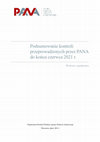
Polish Agency for Audit Oversight, 2021
The analysis of 106 inspection protocols revealed that:
- For different groups of audit firms, c... more The analysis of 106 inspection protocols revealed that:
- For different groups of audit firms, characteristic main irregularities in the functioning of the internal quality control system can be identified. Thus:
- For firms belonging to international networks, the weakest aspect is compliance with Polish conditions and the Polish Act on Certified Auditors.
- For firms auditing Public Interest Entities (PIEs) but not belonging to international networks, the biggest problem is the lack of proper monitoring, inspection, and quality control of assignments.
- Other audit firms (especially micro ones) mainly struggle with the lack of cooperation with other certified auditors, which would allow them to improve quality through better monitoring, quality control of assignments, or consultations.
- A common problem at the level of the quality control system is accurately determining the workload of assignments.
- The most common identified problems in the documentation of financial statement audits are the correct identification and estimation of the risk of material misstatement due to fraud or error, as well as the gathering of sufficient and appropriate audit evidence.
- In the case of documentation of the audit of consolidated financial statements, the most significant problem is assessing the appropriateness, completeness, and accuracy of consolidation adjustments and reclassifications, as well as assessing whether there are fraud risk factors or signs of possible management bias.
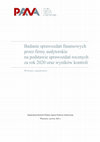
Polish Agency for Audit Oversight, 2021
W niniejszej publikacji przeprowadzona została analiza statystyczna ponad 30 tys. badań sprawozda... more W niniejszej publikacji przeprowadzona została analiza statystyczna ponad 30 tys. badań sprawozdań finansowych wykonanych przez 2257 biegłych rewidentów w ramach 1062 firm audytorskich w oparciu o przekazane przez FA informacje oraz doświadczenia związane z przeprowadzanymi przez Agencję kontrolami.
Przeprowadzona analiza wskazała na:
Istnienie zależności pomiędzy wielkością FA i sposobem organizacji usługi badania (im większa FA tym większy zespół biorący udział w badaniu) co znajduje zwykle odzwierciedlenie w kształtowaniu wynagrodzenia za usługę badania.
Brak jasnej zależności pomiędzy przesłankami wymienionymi w art. 80 ust. 2 (pracochłonność, stopień złożoności prac oraz wymagane kwalifikacje) a wynagrodzeniem FA. Prowadzone przez PANA kontrole wskazały na konieczność pogłębienia procedur badania sprawozdań finansowych a szczególnie na poprawienie zrozumienia przez BR sposobu funkcjonowania podmiotów badanych oraz odzwierciedlenia tego zrozumienia w identyfikowanych ryzykach oraz procedurach mitygujących te ryzyka. Powiązanie tych obu faktów wskazuje na niewłaściwe szacowanie przez FA pracochłonności, niezbędnej do zapewnienia wysokiej jakości badania sprawozdania finansowego.
Nieprawidłowości w zaangażowaniu się przez biegłych rewidentów w badanie. Na obligatoryjność czynnego udziału kluczowego biegłego rewidenta w badaniu wskazuje wprost art. 66 ust. 3 UOBR. Ponadto art. 66 ust. 4 UOBR wskazuje, że kluczowy biegły rewident i firma audytorska przeznaczają wystarczającą ilość czasu i odpowiednie zasoby w celu właściwej realizacji badania. Z przeprowadzonych analiz wynika, że 88 firm audytorskich ma biegłych rewidentów, którzy wykonali powyżej 50 usług w ciągu roku (łącznie 194 takich biegłych). To oznacza, że tacy biegli rewidenci mogli przeznaczyć na badanie sprawozdania finansowego jedynie kilka dni roboczych (a w niektórych przypadkach nawet poniżej 1 dnia). Zjawisko to będzie podlegało szczególnemu nadzorowi jako potencjalnie zagrażające prawidłowości wydanej opinii o badaniu sprawozdania finansowego.

Acta Physica Polonica A, Jun 1, 2018
The insider trading phenomenon is based on the situation when traders use material information no... more The insider trading phenomenon is based on the situation when traders use material information not publicly available to make their investment decisions. In most countries of the world, insider trading is illegal and is punishable by ne or imprisonment. Insider trading has many economic eects, which in the light of available scientic research can be both positive and negative. Insider traders can be divided into primary and secondary traders depending on whether their contact with insider information is direct or indirect. Primary insider trading has been discussed in many research studies and scientic descriptions, while secondary insider trading has not been investigated yet. This paper's aim is to ll this gap. Since the empirical data for secondary insider trading is in practice impossible to obtain, the research analysis is based on simulations of two probabilistic models. The rst one concerns the use of insider information for an innite long period of time after its acquisition, while the second one on the day of its receipt. The results of the simulation are related to three basic models of nancial market functioning: the ecient market hypothesis, the fractal market hypothesis, and the coherent market hypothesis.
Acta Physica Polonica A, May 1, 2016
This article presents a network algorithm for identifying transactions which may constitute a vio... more This article presents a network algorithm for identifying transactions which may constitute a violation of restricted periods, namely, making transactions in company shares by persons possessing inside information. The empirical research was performed on the basis of publicly available information on exchange trading, originating from the Warsaw Stock Exchange. The analysis is based on a numerical model which describes information spreading in a network with an information bottleneck. The applied method can confirm with high probability the use of inside information for carrying out unauthorized stock market transactions.

Acta Physica Polonica A, Jul 1, 2020
Insider trading is the buying or selling of a publicly traded company's stock by someone who has ... more Insider trading is the buying or selling of a publicly traded company's stock by someone who has non-public, material information about that stock. The following article presents an innovative model which could help to solve the major problem of effective detection of insider trading. According to our research, the simultaneous occurrence of an increased volume and price changes without the occurrence of other disturbing factors (e.g., earlier company reports) allows to strongly suspect the occurrence of insider trading. This means that a significant increase in transaction volume is a better indicator of the likely insider trading than a price change alone. By analysing the disclosed case of insider trading on Drewex shares in 2010 we tested the effectiveness of our model and we came to the conclusion that the probability of insider trading in Drewex SA shares was 70%. topics: insider trading, information propagation model, market abuse, financial market, stock exchange

Social Science Research Network, 2022
This publication is intended to inform, in accordance with Article 90(1)(15a)(d) of the ASA, of t... more This publication is intended to inform, in accordance with Article 90(1)(15a)(d) of the ASA, of the main issues concerning the examination of estimates observed during the audits carried out by the Polish Audit Oversight Agency and completed with audit protocols in the period from July 2021 to the end of June 2022. This publication is the result of an analysis of 139 audit protocols resulting from the Agency's implementation of audits (of which 27 protocols related to AFs examining PIEs and 108 to other AFs). As part of these audits, nearly 279 dossiers of services performed by AFs were analysed (of which 80 dossiers related to PIEs and the remaining 199 related to entities other than PIEs). These 279 dossiers included 39 consolidated audit dossiers. The method of analysis contained in the publication was based on the requirements formulated in Article 112(1) of the ASA and on the "Policies and Procedures for the Management of the Audit System and the Conduct of PANA Audits". (Polish Audit Oversight Agency, 2022). During the audit period, the AF used the standard KSB/ISA 540 for estimates in the audit engagements. The standard KSB/ISA 540(Z) was only used in the audits that will be audited by PANA in the next period. This analysis is an extension of the publication "Summary of audits initiated by PANA by the end of June 2021 in relation to fair value estimates. Selected issues" (Polish Audit Oversight Agency, 2021). In view of the purpose of the publication, reference is made to the most common anomalies identified in relation to the audit of estimates, leaving aside the fact that it is correct in principle to give an opinion on the financial statements.
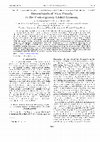
Acta Physica Polonica A, Jun 1, 2018
The concept of mass poverty was dened by Galbraith in late 1970s and it applies to societies with... more The concept of mass poverty was dened by Galbraith in late 1970s and it applies to societies with agriculture as the dominant branch of the economy. This paper examines the importance of this phenomenon and factors aecting it in the contemporary world. There are a growing number of studies supporting the claim that the method of electricity consumption is a key factor of economic growth which makes it possible to escape mass poverty. Moreover, in order to solve the problem, it is necessary to determine access to capital in such countries and societies, understood as M2 aggregate. In this manner, the problem at hand is reduced to determination of the relationships between the following variables: percentage of rural population, rules of managing electrical energy and M2 aggregate. These ndings were used to formulate three study hypotheses. According to the rst hypothesis, the eect of the electricity use method on M2 varies from one country to another, with several identiable patterns. According to the second hypothesis, the process of leaving the mass poverty sphere follows either the BoseEinstein distribution or the Boltzmann distribution. The third hypothesis indicates that eects of eorts aimed at eliminating mass poverty in certain conditions are not permanent. Verication of these three hypotheses indicates the adequacy of the theory of mass poverty in the contemporary world.
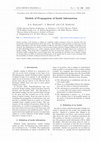
Acta Physica Polonica A, 2020
Insider trading is the buying or selling of a publicly traded company's stock by someone who has ... more Insider trading is the buying or selling of a publicly traded company's stock by someone who has non-public, material information about that stock. The following article presents an innovative model which could help to solve the major problem of effective detection of insider trading. According to our research, the simultaneous occurrence of an increased volume and price changes without the occurrence of other disturbing factors (e.g., earlier company reports) allows to strongly suspect the occurrence of insider trading. This means that a significant increase in transaction volume is a better indicator of the likely insider trading than a price change alone. By analysing the disclosed case of insider trading on Drewex shares in 2010 we tested the effectiveness of our model and we came to the conclusion that the probability of insider trading in Drewex SA shares was 70%. topics: insider trading, information propagation model, market abuse, financial market, stock exchange










Uploads
Papers by Agnieszka Baklarz
Results: The article confi rms the existence of a dependence of the remuneration for statutory audit services on the type of the fi nancial statement audited, the “high” or “low” season of performing the audit and the distance between the audit fi rm and the entity audited. In addition, it focuses on a deeper understanding of the sign of the coefficient appearing in the model with the variable indicating the season. The study has also indicated a trend of undertaking fi nancial statement audit assignments from entities relatively more distant from the audit firm.
- a more proactive approach to quality management adapted to the method and scope of operation of the audit firm, by focusing on achieving the set quality objectives, identified quality risks related to these objectives and responding to such risks (hereinafter referred to as the company's risk assessment process),
- greater emphasis on corporate governance and leadership requirements, including increased responsibilities and accountability of the management itself,
- modernization of standards by taking into account technology requirements, network requirements, use of external service providers,
- new information and communication requirements,
- enhanced requirements for the monitoring and remediation process to more proactively monitor the IQCS of the audit firm and correct weaknesses effectively and in a timely manner.
Summing up the irregularities in the design of the IQCS, which in particular translate into an increased risk of irregularities in the examination, the following should be pointed out:
- lack of or unclear rules related to the need to use consultations;
- lack of, unclear or unmatched with the activities of the audit firm rules related to the selection of documentation of the engagement for quality control;
- lack or imprecise manner of defining the principles of performing the quality control;
- lack of or unclear rules of rotation of the key statutory auditor or quality controller related to minimizing risks related to independence; in relation to this point, the lack of compliance with the provisions of the KSKJ1 as well as the IESBA code of ethics should also be indicated;
- lack of definition of the method of conducting ongoing monitoring;
- lack of or unclear rules for selecting a partner or an engagement for inspection;
- lack of or imprecise description of the rules for carrying out the engagement inspection;
- lack of information on how to find the root cause of irregularities;
- lack of or unclear rules for periodic monitoring, not adapted to the activities of the audit firm (along with specifying who will carry out such monitoring).
The main problem highlighted during the thematic review was the mismatch between the IQCS adapted by the individual audit firms and their actual activities. Therefore, when preparing the inspection procedures, the Agency decided to divide them due to the differences in the law (regulation, act and quality control standards) and prepared separate control procedures in relation to:
- audit firms examining public interest entities (the need to verify the fulfillment of the requirements of Regulation 537/2014 and the increased requirements of the Act and standards);
- staffed audit firms that do not audit public interest entities;
- unstaffed audit firms that do not audit public interest entities (due to the possibility of not taking into account some of the requirements of the KSKJ1).
1) Regarding the legal forms of AF, there is a trend of gradually decreasing participation of sole proprietorships and transforming AF into joint-stock companies.
2) There is a visible decrease in the number of AF performing financial audit activities (hereinafter referred to as active AF) with a slightly decreasing number of audit firms (BR) conducting audits.
3) The average number of statutory audits of financial statements of entities other than Public Interest Entities (JZP) in AF outside the TOP12 decreased to 11 audits. The number of audits of financial statements of entities other than JZP in firms from the TOP12 dropped to an average of 25 audits per 1 auditor for the company.
4) The number of AF with auditors performing over 50 services per year decreased to 68 (in 2022, there were a total of 150 such BR), indicating a better understanding of the need to allocate sufficient time for auditing by BR and AF. The Agency pays special attention to this phenomenon during inspections, publications, and communications, and gradual improvement should be positively assessed.
5) Information provided in the annual reports submitted by AF indicates that in 2022, 1,999 reports on the audit of statutory financial statements of JZP were issued, and 29,169 reports on the audit of statutory financial statements of entities other than JZP were issued. Regarding the audit of financial statements of JZP, 88.7% of opinions were unqualified (compared to 88.4% in 2021). Unqualified opinions, including opinions with explanatory paragraphs, accounted for, as in 2020 and 2021, 97.5% of all issued opinions. Also, concerning the audit of financial statements of entities other than JZP, the most frequent opinion issued was unqualified (82.4%, compared to 79.7% in 2021) as well as unqualified with explanatory paragraphs (12.8%, compared to 14.5% in 2021), totaling 95.2% of all issued opinions (in 2021 - 94.2%). Qualified opinions accounted for 4.5% of all issued opinions (compared to 5.5% in 2021).
6) Generally, there has been a gradual increase in audit fees. This increase is around 17%, slightly above the inflation rate for 2022 (according to data from the Central Statistical Office, the average annual consumer price index in 2022 was 14.1%).
7) Regarding the audit of funds and sub-funds, it should be noted that audit fees for this segment of audit firms are low and have essentially not increased despite a significant increase in the cost of employees performing work on audits and the cost of valuations performed by experts employed by AF.
8) The analysis of the number of audits of JZP and the fees for these audits confirms that there is a phenomenon of de-concentration of audits in the industrial processing, wholesale and retail trade, information and communication, and professional, scientific, and technical activities sectors. This is also evident in changes in fees in individual groups of audit firms. However, it is difficult to speak about de-concentration of audits in the financial and insurance activities (including associated investment funds and sub-funds) as well as in the construction industry.
9) Audits of entities other than JZP are carried out by audit firms outside the TOP12 in 75% of cases (i.e., in relation to approximately 22,000 statutory audits). However, concerning the total value of these audits, TOP12 firms perform 60% of audits, and BIG4 - 48%. In 2022, there was an increase in the number of audited financial statements by 4%. The increase mainly affected audits performed by TOP12 firms (2.5%) rather than other audit firms (1.5%). Audit firms outside the TOP12 have a dominant position in all types of audits; however, financial activities (including investment funds) are audited by TOP12 firms in close to half of the cases.
10) Regarding audits of entities other than JZP conducted by BIG4, there was a slight decrease in the number of audits of financial statements (about 1% compared to 2021). Regardless of this fact, BIG4's revenues from audits of entities other than JZP increased by approximately 12%. Of particular note is the nearly 60% increase in fees for auditing funds and sub-funds (the median value of this fee in BIG4 is over three times the median for the entire non-JZP audit market). This is the only industry where such a significant increase in fees was recorded in BIG4, and this increase continues the trend from 2021 when these fees increased by 80%. However, it should be noted that the number of funds and sub-funds audited by BIG4 accounts for only 11% of the total number of audits performed by all audit firms.
11) The structure of total revenues of AF shown in the annual reports in 2022 indicates different behavior patterns of individual groups of AF. AF from the TOP12 specialize in and mainly perform financial audit services (mostly statutory audits and reviews of financial statements). Within other services, AF from the TOP12 mainly provide unqualified attestation services not reserved for statutory auditors and related services. Other AF mainly rely on services other than financial auditing. In the case of AF from outside the TOP12 providing services to JZP, the most important
- Lack of significant interest from supervisory boards and management in the quality of financial reporting (including lack of communication with auditors).
- Outsourcing of accounting to accounting offices without internal control.
- Emphasis on tax accounting.
- Low attention to interim reporting.
- Sole reliance on price in selecting audit firms.
These factors are also reflected in thematic inspection findings, such as:
- Lack of documentation of communication with supervisory boards and management.
- Difficult and insufficient communication with accounting offices.
- Failure to evaluate the entity's internal control over financial reporting processes.
- Underestimation of the workload leading to inadequate audit procedures, lack of necessary consultations, failure to obtain other resources (e.g., permanent assistants ensuring adequate quality), and lack of use of quality control reviewer.
Regarding financial statement items, investors have indicated important but highly risky areas of financial reporting:
- Intangible assets and intellectual property (with particular emphasis on know-how and research and development activities).
- Financial assets (shares, stocks, and loans).
- Research and development activities (interim settlements).
- Provisions for liabilities.
Additionally, investors have raised concerns about the weak financial condition of ASO entities. It should be noted that key audit matters presented in the audit report largely reflect these areas, enriched with revenue-related risks and fraud risks. However, this reflection is not consistent with the documentation of procedures conducted by the auditor. Auditors inadequately document activities related to assessing:
- Going concern (also due to lack of communication with management and the supervisory board).
- The accuracy of significant estimates (due to poor communication with accounting offices and limitations in hiring necessary experts).
- Fraud risk.
It is also worth noting that as a result of inspections, insufficient quality of verification of a key element of the financial statement, the cash flow statement, is observed. Deficiencies in this area are rarely indicated in audit reports despite identified errors in this area during inspections.
The analysis of inspection protocols identified the main discrepancies in understanding by the auditors under review the standardization principles of ESEF document files. According to Delegated Regulation 2019/815, the entire annual report should be prepared in XHTML format. In particular (in addition to the Financial Statement or Consolidated Financial Statement), the Activity Report and the Audit Report should be prepared in this format (as required by the regulation of the Minister of Finance of March 29, 2018, regarding ongoing and periodic information provided by securities issuers and conditions for recognizing as equivalent information required by the law of a non-member state (Journal of Laws of 2018, item 757)). The XHTML format entails a set of technical requirements that the ESEF document must meet. The mere fact that the file extension is labeled with "XHTML" or even the ability to open the file in a browser does not guarantee its correctness. Therefore, validation is necessary, for example, using an available validator. Consequently, the auditor attesting to the correctness of the report's form must subject it to appropriate validation.
Another common mistake is incorrect labeling regarding mandatory tags in consolidated financial statements. The idea behind ESEF is to enable machine-readable data, thereby facilitating data analysis, including aggregation. Mandatory tags (currently there are 10) contain data that is crucial for analysis, such as data grouping, etc. Incorrect labeling of data such as country, business form, or parent entity prevents data aggregation and analysis based on these criteria. A large number of errors make data aggregation or comparison very difficult, sometimes even impossible. There are also cases where the audit was conducted based on a file that is not an ESEF document, and an audit report was issued concerning such a file.
However, compared to the previous year, there has been an improvement in the quality of documentation in audits of financial statements of entities other than PIEs. Nevertheless, attention is still drawn to significant weaknesses in the planning phase, which affects the entire audit.
1) Changes in the structure of PA forms indicate a gradual decrease in the proportion of sole proprietorships and the transformation of PAs into capital companies. There is a visible decrease in the number of PAs conducting financial audit activities (hereinafter referred to as active PAs) with a slightly decreasing number of audit teams performing audits.
2) The average number of statutory financial statement audits for entities other than Public Interest Entities (PIEs) in PAs outside the TOP11 increased to 12 audits (compared to around 11 audits in 2020), confirming the growing concentration of audits in individual PAs. The number of audits of financial statements for entities other than PIEs in firms within the TOP11 increased to an average of 32 audits per certified auditor for a given firm (compared to 27 audits in 2020).
3) The number of PAs with certified auditors performing over 50 services per year decreased from 88 to 76 (in 2021, there were a total of 174 such auditors – in 2020, there were 194), indicating a better understanding of the need to dedicate sufficient time to auditing by audit teams and PAs, as noted by the Agency during inspections, publications, and communications.
4) In 2021, 2035 opinions were issued on the audit of statutory financial statements of PIEs (compared to 1898 opinions in 2020), and 28,041 opinions were issued on the audit of statutory financial statements for entities other than PIEs. Regarding the audits of PIE financial statements, 88.4% of the opinions were unqualified (compared to 78.5% in 2020). Unqualified opinions, including opinions with an explanatory paragraph, accounted for 97.8% of all issued opinions, similar to 2020. In relation to audits of financial statements for entities other than PIEs, the most common opinion issued was an unqualified opinion (79.7%, compared to 74.4% in 2020), followed by an unqualified opinion with an explanatory paragraph (14.5%, compared to 20.9% in 2020), totaling 94.2% of all issued opinions (compared to 93.3% in 2020). Qualified opinions accounted for 5.5% of all issued opinions (compared to 4.3% in 2020).
5) Generally, there is a gradual, albeit slight, increase in audit fees. This increase is on average slightly above the inflation rate for 2021, around 7% (according to data from the Central Statistical Office, the average annual consumer price index for goods and services in 2021 was 5.1%). The increase in fees was stronger in PAs within the TOP11 (especially in PAs within the BIG4 group), which focused their activities on audits with high workload while simultaneously reducing the number of serviced entities (for BIG4, the number of audits of financial statements for entities other than PIEs decreased by nearly 23%).
6) Significant changes occurred in the structure of entities performing audits of investment funds and sub-funds. While the majority of audits (close to 80% in 2021, compared to 72% in 2020) of investment funds and sub-funds that are PIEs were conducted by BIG4 in 2021, funds and sub-funds not being PIEs are serviced by them to a negligible extent (only 10% in 2021, compared to 32% in 2020).
7) The structure of total revenues of PAs indicated in the annual reports in 2021 indicates different behavioral patterns among individual groups of PAs. PAs within the TOP11 specialize mainly in providing financial audit services (mostly statutory audits and reviews of financial statements). As part of other services, PAs within the TOP11 mainly provide unqualified attestation services and related services. Other PAs mainly rely on services other than financial audit. In the case of PAs outside the TOP11 providing services to PIEs, the most important service besides financial audit is tax advisory. For PAs outside the TOP11 providing services exclusively to entities other than PIEs, the main sources of revenue are service bookkeeping, tax advisory, and general advisory services.
- Assessing the impact of events after the balance sheet date on the accuracy of the estimate
- Verifying the sources of data upon which management determined the value of estimates
- Inconsistencies in the applied fair value measurement models and assumptions related to the models
- Incorrect assessment of the reasonableness of estimates and their distortions
- Improper documentation of the basis of formulated conclusions by the audit team
- Irregularities in documenting signs of possible management bias regarding estimates
- For different groups of audit firms, characteristic main irregularities in the functioning of the internal quality control system can be identified. Thus:
- For firms belonging to international networks, the weakest aspect is compliance with Polish conditions and the Polish Act on Certified Auditors.
- For firms auditing Public Interest Entities (PIEs) but not belonging to international networks, the biggest problem is the lack of proper monitoring, inspection, and quality control of assignments.
- Other audit firms (especially micro ones) mainly struggle with the lack of cooperation with other certified auditors, which would allow them to improve quality through better monitoring, quality control of assignments, or consultations.
- A common problem at the level of the quality control system is accurately determining the workload of assignments.
- The most common identified problems in the documentation of financial statement audits are the correct identification and estimation of the risk of material misstatement due to fraud or error, as well as the gathering of sufficient and appropriate audit evidence.
- In the case of documentation of the audit of consolidated financial statements, the most significant problem is assessing the appropriateness, completeness, and accuracy of consolidation adjustments and reclassifications, as well as assessing whether there are fraud risk factors or signs of possible management bias.
Przeprowadzona analiza wskazała na:
Istnienie zależności pomiędzy wielkością FA i sposobem organizacji usługi badania (im większa FA tym większy zespół biorący udział w badaniu) co znajduje zwykle odzwierciedlenie w kształtowaniu wynagrodzenia za usługę badania.
Brak jasnej zależności pomiędzy przesłankami wymienionymi w art. 80 ust. 2 (pracochłonność, stopień złożoności prac oraz wymagane kwalifikacje) a wynagrodzeniem FA. Prowadzone przez PANA kontrole wskazały na konieczność pogłębienia procedur badania sprawozdań finansowych a szczególnie na poprawienie zrozumienia przez BR sposobu funkcjonowania podmiotów badanych oraz odzwierciedlenia tego zrozumienia w identyfikowanych ryzykach oraz procedurach mitygujących te ryzyka. Powiązanie tych obu faktów wskazuje na niewłaściwe szacowanie przez FA pracochłonności, niezbędnej do zapewnienia wysokiej jakości badania sprawozdania finansowego.
Nieprawidłowości w zaangażowaniu się przez biegłych rewidentów w badanie. Na obligatoryjność czynnego udziału kluczowego biegłego rewidenta w badaniu wskazuje wprost art. 66 ust. 3 UOBR. Ponadto art. 66 ust. 4 UOBR wskazuje, że kluczowy biegły rewident i firma audytorska przeznaczają wystarczającą ilość czasu i odpowiednie zasoby w celu właściwej realizacji badania. Z przeprowadzonych analiz wynika, że 88 firm audytorskich ma biegłych rewidentów, którzy wykonali powyżej 50 usług w ciągu roku (łącznie 194 takich biegłych). To oznacza, że tacy biegli rewidenci mogli przeznaczyć na badanie sprawozdania finansowego jedynie kilka dni roboczych (a w niektórych przypadkach nawet poniżej 1 dnia). Zjawisko to będzie podlegało szczególnemu nadzorowi jako potencjalnie zagrażające prawidłowości wydanej opinii o badaniu sprawozdania finansowego.
Results: The article confi rms the existence of a dependence of the remuneration for statutory audit services on the type of the fi nancial statement audited, the “high” or “low” season of performing the audit and the distance between the audit fi rm and the entity audited. In addition, it focuses on a deeper understanding of the sign of the coefficient appearing in the model with the variable indicating the season. The study has also indicated a trend of undertaking fi nancial statement audit assignments from entities relatively more distant from the audit firm.
- a more proactive approach to quality management adapted to the method and scope of operation of the audit firm, by focusing on achieving the set quality objectives, identified quality risks related to these objectives and responding to such risks (hereinafter referred to as the company's risk assessment process),
- greater emphasis on corporate governance and leadership requirements, including increased responsibilities and accountability of the management itself,
- modernization of standards by taking into account technology requirements, network requirements, use of external service providers,
- new information and communication requirements,
- enhanced requirements for the monitoring and remediation process to more proactively monitor the IQCS of the audit firm and correct weaknesses effectively and in a timely manner.
Summing up the irregularities in the design of the IQCS, which in particular translate into an increased risk of irregularities in the examination, the following should be pointed out:
- lack of or unclear rules related to the need to use consultations;
- lack of, unclear or unmatched with the activities of the audit firm rules related to the selection of documentation of the engagement for quality control;
- lack or imprecise manner of defining the principles of performing the quality control;
- lack of or unclear rules of rotation of the key statutory auditor or quality controller related to minimizing risks related to independence; in relation to this point, the lack of compliance with the provisions of the KSKJ1 as well as the IESBA code of ethics should also be indicated;
- lack of definition of the method of conducting ongoing monitoring;
- lack of or unclear rules for selecting a partner or an engagement for inspection;
- lack of or imprecise description of the rules for carrying out the engagement inspection;
- lack of information on how to find the root cause of irregularities;
- lack of or unclear rules for periodic monitoring, not adapted to the activities of the audit firm (along with specifying who will carry out such monitoring).
The main problem highlighted during the thematic review was the mismatch between the IQCS adapted by the individual audit firms and their actual activities. Therefore, when preparing the inspection procedures, the Agency decided to divide them due to the differences in the law (regulation, act and quality control standards) and prepared separate control procedures in relation to:
- audit firms examining public interest entities (the need to verify the fulfillment of the requirements of Regulation 537/2014 and the increased requirements of the Act and standards);
- staffed audit firms that do not audit public interest entities;
- unstaffed audit firms that do not audit public interest entities (due to the possibility of not taking into account some of the requirements of the KSKJ1).
1) Regarding the legal forms of AF, there is a trend of gradually decreasing participation of sole proprietorships and transforming AF into joint-stock companies.
2) There is a visible decrease in the number of AF performing financial audit activities (hereinafter referred to as active AF) with a slightly decreasing number of audit firms (BR) conducting audits.
3) The average number of statutory audits of financial statements of entities other than Public Interest Entities (JZP) in AF outside the TOP12 decreased to 11 audits. The number of audits of financial statements of entities other than JZP in firms from the TOP12 dropped to an average of 25 audits per 1 auditor for the company.
4) The number of AF with auditors performing over 50 services per year decreased to 68 (in 2022, there were a total of 150 such BR), indicating a better understanding of the need to allocate sufficient time for auditing by BR and AF. The Agency pays special attention to this phenomenon during inspections, publications, and communications, and gradual improvement should be positively assessed.
5) Information provided in the annual reports submitted by AF indicates that in 2022, 1,999 reports on the audit of statutory financial statements of JZP were issued, and 29,169 reports on the audit of statutory financial statements of entities other than JZP were issued. Regarding the audit of financial statements of JZP, 88.7% of opinions were unqualified (compared to 88.4% in 2021). Unqualified opinions, including opinions with explanatory paragraphs, accounted for, as in 2020 and 2021, 97.5% of all issued opinions. Also, concerning the audit of financial statements of entities other than JZP, the most frequent opinion issued was unqualified (82.4%, compared to 79.7% in 2021) as well as unqualified with explanatory paragraphs (12.8%, compared to 14.5% in 2021), totaling 95.2% of all issued opinions (in 2021 - 94.2%). Qualified opinions accounted for 4.5% of all issued opinions (compared to 5.5% in 2021).
6) Generally, there has been a gradual increase in audit fees. This increase is around 17%, slightly above the inflation rate for 2022 (according to data from the Central Statistical Office, the average annual consumer price index in 2022 was 14.1%).
7) Regarding the audit of funds and sub-funds, it should be noted that audit fees for this segment of audit firms are low and have essentially not increased despite a significant increase in the cost of employees performing work on audits and the cost of valuations performed by experts employed by AF.
8) The analysis of the number of audits of JZP and the fees for these audits confirms that there is a phenomenon of de-concentration of audits in the industrial processing, wholesale and retail trade, information and communication, and professional, scientific, and technical activities sectors. This is also evident in changes in fees in individual groups of audit firms. However, it is difficult to speak about de-concentration of audits in the financial and insurance activities (including associated investment funds and sub-funds) as well as in the construction industry.
9) Audits of entities other than JZP are carried out by audit firms outside the TOP12 in 75% of cases (i.e., in relation to approximately 22,000 statutory audits). However, concerning the total value of these audits, TOP12 firms perform 60% of audits, and BIG4 - 48%. In 2022, there was an increase in the number of audited financial statements by 4%. The increase mainly affected audits performed by TOP12 firms (2.5%) rather than other audit firms (1.5%). Audit firms outside the TOP12 have a dominant position in all types of audits; however, financial activities (including investment funds) are audited by TOP12 firms in close to half of the cases.
10) Regarding audits of entities other than JZP conducted by BIG4, there was a slight decrease in the number of audits of financial statements (about 1% compared to 2021). Regardless of this fact, BIG4's revenues from audits of entities other than JZP increased by approximately 12%. Of particular note is the nearly 60% increase in fees for auditing funds and sub-funds (the median value of this fee in BIG4 is over three times the median for the entire non-JZP audit market). This is the only industry where such a significant increase in fees was recorded in BIG4, and this increase continues the trend from 2021 when these fees increased by 80%. However, it should be noted that the number of funds and sub-funds audited by BIG4 accounts for only 11% of the total number of audits performed by all audit firms.
11) The structure of total revenues of AF shown in the annual reports in 2022 indicates different behavior patterns of individual groups of AF. AF from the TOP12 specialize in and mainly perform financial audit services (mostly statutory audits and reviews of financial statements). Within other services, AF from the TOP12 mainly provide unqualified attestation services not reserved for statutory auditors and related services. Other AF mainly rely on services other than financial auditing. In the case of AF from outside the TOP12 providing services to JZP, the most important
- Lack of significant interest from supervisory boards and management in the quality of financial reporting (including lack of communication with auditors).
- Outsourcing of accounting to accounting offices without internal control.
- Emphasis on tax accounting.
- Low attention to interim reporting.
- Sole reliance on price in selecting audit firms.
These factors are also reflected in thematic inspection findings, such as:
- Lack of documentation of communication with supervisory boards and management.
- Difficult and insufficient communication with accounting offices.
- Failure to evaluate the entity's internal control over financial reporting processes.
- Underestimation of the workload leading to inadequate audit procedures, lack of necessary consultations, failure to obtain other resources (e.g., permanent assistants ensuring adequate quality), and lack of use of quality control reviewer.
Regarding financial statement items, investors have indicated important but highly risky areas of financial reporting:
- Intangible assets and intellectual property (with particular emphasis on know-how and research and development activities).
- Financial assets (shares, stocks, and loans).
- Research and development activities (interim settlements).
- Provisions for liabilities.
Additionally, investors have raised concerns about the weak financial condition of ASO entities. It should be noted that key audit matters presented in the audit report largely reflect these areas, enriched with revenue-related risks and fraud risks. However, this reflection is not consistent with the documentation of procedures conducted by the auditor. Auditors inadequately document activities related to assessing:
- Going concern (also due to lack of communication with management and the supervisory board).
- The accuracy of significant estimates (due to poor communication with accounting offices and limitations in hiring necessary experts).
- Fraud risk.
It is also worth noting that as a result of inspections, insufficient quality of verification of a key element of the financial statement, the cash flow statement, is observed. Deficiencies in this area are rarely indicated in audit reports despite identified errors in this area during inspections.
The analysis of inspection protocols identified the main discrepancies in understanding by the auditors under review the standardization principles of ESEF document files. According to Delegated Regulation 2019/815, the entire annual report should be prepared in XHTML format. In particular (in addition to the Financial Statement or Consolidated Financial Statement), the Activity Report and the Audit Report should be prepared in this format (as required by the regulation of the Minister of Finance of March 29, 2018, regarding ongoing and periodic information provided by securities issuers and conditions for recognizing as equivalent information required by the law of a non-member state (Journal of Laws of 2018, item 757)). The XHTML format entails a set of technical requirements that the ESEF document must meet. The mere fact that the file extension is labeled with "XHTML" or even the ability to open the file in a browser does not guarantee its correctness. Therefore, validation is necessary, for example, using an available validator. Consequently, the auditor attesting to the correctness of the report's form must subject it to appropriate validation.
Another common mistake is incorrect labeling regarding mandatory tags in consolidated financial statements. The idea behind ESEF is to enable machine-readable data, thereby facilitating data analysis, including aggregation. Mandatory tags (currently there are 10) contain data that is crucial for analysis, such as data grouping, etc. Incorrect labeling of data such as country, business form, or parent entity prevents data aggregation and analysis based on these criteria. A large number of errors make data aggregation or comparison very difficult, sometimes even impossible. There are also cases where the audit was conducted based on a file that is not an ESEF document, and an audit report was issued concerning such a file.
However, compared to the previous year, there has been an improvement in the quality of documentation in audits of financial statements of entities other than PIEs. Nevertheless, attention is still drawn to significant weaknesses in the planning phase, which affects the entire audit.
1) Changes in the structure of PA forms indicate a gradual decrease in the proportion of sole proprietorships and the transformation of PAs into capital companies. There is a visible decrease in the number of PAs conducting financial audit activities (hereinafter referred to as active PAs) with a slightly decreasing number of audit teams performing audits.
2) The average number of statutory financial statement audits for entities other than Public Interest Entities (PIEs) in PAs outside the TOP11 increased to 12 audits (compared to around 11 audits in 2020), confirming the growing concentration of audits in individual PAs. The number of audits of financial statements for entities other than PIEs in firms within the TOP11 increased to an average of 32 audits per certified auditor for a given firm (compared to 27 audits in 2020).
3) The number of PAs with certified auditors performing over 50 services per year decreased from 88 to 76 (in 2021, there were a total of 174 such auditors – in 2020, there were 194), indicating a better understanding of the need to dedicate sufficient time to auditing by audit teams and PAs, as noted by the Agency during inspections, publications, and communications.
4) In 2021, 2035 opinions were issued on the audit of statutory financial statements of PIEs (compared to 1898 opinions in 2020), and 28,041 opinions were issued on the audit of statutory financial statements for entities other than PIEs. Regarding the audits of PIE financial statements, 88.4% of the opinions were unqualified (compared to 78.5% in 2020). Unqualified opinions, including opinions with an explanatory paragraph, accounted for 97.8% of all issued opinions, similar to 2020. In relation to audits of financial statements for entities other than PIEs, the most common opinion issued was an unqualified opinion (79.7%, compared to 74.4% in 2020), followed by an unqualified opinion with an explanatory paragraph (14.5%, compared to 20.9% in 2020), totaling 94.2% of all issued opinions (compared to 93.3% in 2020). Qualified opinions accounted for 5.5% of all issued opinions (compared to 4.3% in 2020).
5) Generally, there is a gradual, albeit slight, increase in audit fees. This increase is on average slightly above the inflation rate for 2021, around 7% (according to data from the Central Statistical Office, the average annual consumer price index for goods and services in 2021 was 5.1%). The increase in fees was stronger in PAs within the TOP11 (especially in PAs within the BIG4 group), which focused their activities on audits with high workload while simultaneously reducing the number of serviced entities (for BIG4, the number of audits of financial statements for entities other than PIEs decreased by nearly 23%).
6) Significant changes occurred in the structure of entities performing audits of investment funds and sub-funds. While the majority of audits (close to 80% in 2021, compared to 72% in 2020) of investment funds and sub-funds that are PIEs were conducted by BIG4 in 2021, funds and sub-funds not being PIEs are serviced by them to a negligible extent (only 10% in 2021, compared to 32% in 2020).
7) The structure of total revenues of PAs indicated in the annual reports in 2021 indicates different behavioral patterns among individual groups of PAs. PAs within the TOP11 specialize mainly in providing financial audit services (mostly statutory audits and reviews of financial statements). As part of other services, PAs within the TOP11 mainly provide unqualified attestation services and related services. Other PAs mainly rely on services other than financial audit. In the case of PAs outside the TOP11 providing services to PIEs, the most important service besides financial audit is tax advisory. For PAs outside the TOP11 providing services exclusively to entities other than PIEs, the main sources of revenue are service bookkeeping, tax advisory, and general advisory services.
- Assessing the impact of events after the balance sheet date on the accuracy of the estimate
- Verifying the sources of data upon which management determined the value of estimates
- Inconsistencies in the applied fair value measurement models and assumptions related to the models
- Incorrect assessment of the reasonableness of estimates and their distortions
- Improper documentation of the basis of formulated conclusions by the audit team
- Irregularities in documenting signs of possible management bias regarding estimates
- For different groups of audit firms, characteristic main irregularities in the functioning of the internal quality control system can be identified. Thus:
- For firms belonging to international networks, the weakest aspect is compliance with Polish conditions and the Polish Act on Certified Auditors.
- For firms auditing Public Interest Entities (PIEs) but not belonging to international networks, the biggest problem is the lack of proper monitoring, inspection, and quality control of assignments.
- Other audit firms (especially micro ones) mainly struggle with the lack of cooperation with other certified auditors, which would allow them to improve quality through better monitoring, quality control of assignments, or consultations.
- A common problem at the level of the quality control system is accurately determining the workload of assignments.
- The most common identified problems in the documentation of financial statement audits are the correct identification and estimation of the risk of material misstatement due to fraud or error, as well as the gathering of sufficient and appropriate audit evidence.
- In the case of documentation of the audit of consolidated financial statements, the most significant problem is assessing the appropriateness, completeness, and accuracy of consolidation adjustments and reclassifications, as well as assessing whether there are fraud risk factors or signs of possible management bias.
Przeprowadzona analiza wskazała na:
Istnienie zależności pomiędzy wielkością FA i sposobem organizacji usługi badania (im większa FA tym większy zespół biorący udział w badaniu) co znajduje zwykle odzwierciedlenie w kształtowaniu wynagrodzenia za usługę badania.
Brak jasnej zależności pomiędzy przesłankami wymienionymi w art. 80 ust. 2 (pracochłonność, stopień złożoności prac oraz wymagane kwalifikacje) a wynagrodzeniem FA. Prowadzone przez PANA kontrole wskazały na konieczność pogłębienia procedur badania sprawozdań finansowych a szczególnie na poprawienie zrozumienia przez BR sposobu funkcjonowania podmiotów badanych oraz odzwierciedlenia tego zrozumienia w identyfikowanych ryzykach oraz procedurach mitygujących te ryzyka. Powiązanie tych obu faktów wskazuje na niewłaściwe szacowanie przez FA pracochłonności, niezbędnej do zapewnienia wysokiej jakości badania sprawozdania finansowego.
Nieprawidłowości w zaangażowaniu się przez biegłych rewidentów w badanie. Na obligatoryjność czynnego udziału kluczowego biegłego rewidenta w badaniu wskazuje wprost art. 66 ust. 3 UOBR. Ponadto art. 66 ust. 4 UOBR wskazuje, że kluczowy biegły rewident i firma audytorska przeznaczają wystarczającą ilość czasu i odpowiednie zasoby w celu właściwej realizacji badania. Z przeprowadzonych analiz wynika, że 88 firm audytorskich ma biegłych rewidentów, którzy wykonali powyżej 50 usług w ciągu roku (łącznie 194 takich biegłych). To oznacza, że tacy biegli rewidenci mogli przeznaczyć na badanie sprawozdania finansowego jedynie kilka dni roboczych (a w niektórych przypadkach nawet poniżej 1 dnia). Zjawisko to będzie podlegało szczególnemu nadzorowi jako potencjalnie zagrażające prawidłowości wydanej opinii o badaniu sprawozdania finansowego.